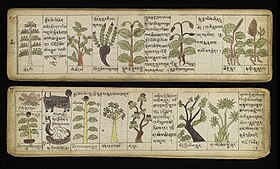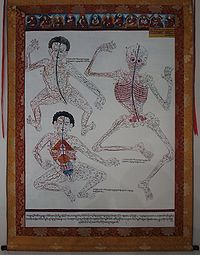|
Traditional Tibetan medicine
Traditional Tibetan medicine refers to a centuries-old traditional medical system that employs a complex approach to diagnosis, incorporating techniques such as Venesection, Moxibustion, Compression Therapy, Medicinal Bathing, massage and pharmacology that relies on a complex formulary of multi-ingredient drugs that use herbs, minerals, metals, and animal products.[1][2][3] The Tibetan medical system is based upon indigenous health practices[citation needed] and Tibetan Buddhist literature (for example Abhidharma and Vajrayāna tantras). In addition to the Tibetan areas of China, the areas in which Tibetan medicine has spread include the Ladakh and Sikkim regions of northern India, the western and northern parts of Nepal and the entire territory of Bhutan. China's Inner Mongolia, Xinjiang and the Mongolian-populated areas in the northeast have historical been greatly influences of Tibetan medicine. The traditional medicine of Mongolia and the Buryat and Tuva regions of the Russian Federation, as well as the Republic of Kalmykia, located in the Volga River basin, is also predominantly Tibetan medicine. It embraces the traditional Buddhist belief that all illness ultimately results from the three poisons: delusion, greed and aversion. Tibetan medicine follows the Buddha's Four Noble Truths which apply medical diagnostic logic to suffering.[4][5] HistoryAs Indian culture flooded Tibet in the eleventh and twelfth centuries, a number of Indian medical texts were also transmitted.[6] For example, the Ayurvedic Astāngahrdayasamhitā (Heart of Medicine Compendium attributed to Vagbhata) was translated into Tibetan by རིན་ཆེན་བཟང་པོ། (Rinchen Zangpo) (957–1055).[7] Tibet also absorbed the early Indian Abhidharma literature, for example the fifth-century Abhidharmakosasabhasyam by Vasubandhu, which expounds upon medical topics, such as fetal development.[8] A wide range of Indian Vajrayana tantras, containing practices based on medical anatomy, were subsequently absorbed into Tibet.[9][10] It was the aboriginal Tibetan people's accumulative knowledge of their local plants and their various usages for benefiting people's health that were collected by སྟོན་པོ་གཤེན་རབ་མི་བོ་ཆེ། the Tonpa Shenrab Miwoche and passed down to one of his sons. Later Yuthok Yontan Gonpo perfected it and there was no author for the books, because at the time it was politically incorrect to mention anything related to Bon nor faith in it.[11]  གཡུ་ཐོག་ཡོན་ཏན་མགོན་པོ། (Yuthok Yontan Gonpo) adapted and synthesized the Four Tantras in the 12th Century. The Four Tantras are scholarly debated as having Indian origins or, as Remedy Master Buddha Bhaisajyaguru's word or, as authentically Tibetan. It was not formally taught in schools at first but, intertwined with Tibetan Buddhism. Around the turn of the 14th century, the Drangti family of physicians established a curriculum for the Four Tantras (and the supplementary literature from the Yutok school) at ས་སྐྱ་དགོན། (Sakya Monastery).[12] The ཏཱ་ལའི་བླ་མ་སྐུ་ཕྲེང་ལྔ་བ། (5th Dalai Lama) supported སྡེ་སྲིད་སངས་རྒྱས་རྒྱ་མཚོ། (Desi Sangye Gyatso) to found the Chagpori College of Medicine in 1696. Chagpori taught Gyamtso's Blue Beryl as well as the Four Tantras in a model that spread throughout Tibet along with the oral tradition.[4] In the 18th century, the missionaries who arrived in Tibet gave a detailed introduction to Tibetan medicine in their travelogues, and in 1789 the British surgeon Robert Saunder published an article on the concocting process of Tibetan medicines.[13] In the 1850s, the Russian capital, Saint Petersburg, opened a clinic of Tibetan medicine and a specialized school of Tibetan medicine.[14][15] In 1898, a part of the Tibetan medical masterpiece Four Medical Classics, was translated into Russian.[16] In Poland, Tibetan medicine was practiced in the 1920s, and two presidents, Stanisław Wojciechowski and Ignacy Mościcki, were both treated with Tibetan medicine.[17] In 1969, the PADMA AG in Zurich, Switzerland, the first Western company specializing in the production and sale of Tibetan medicine was established.[18] In September 1959, the Tibetan People's Government merged "Menzikang" (སྨན་རྩིས་ཁང་) and Chagpori College of Medicine and established the Lhasa Tibetan Hospital on this basis. In September 1961, at the congress of Tibetan doctors in Lhasa area, Chingpo Lobu was appointed as the director of Lhasa Tibetan Hospital. On September 1, 1980, the Tibet Autonomous Region expanded Lhasa Tibetan Hospital to become Tibetan Hospital of Tibet Autonomous Region (西藏自治区藏医院), laying a solid foundation for the vigorous development of Tibetan medicine.[19] In 1999, Tibet Nordicam Pharmaceuticals Co., Ltd. became the first high-tech pharmaceutical listed enterprise born in Tibet Autonomous Region.[20] In 2006, the first Tibetan medicine group in Tibet Autonomous Region was established in Lhasa, marking the establishment of a mature modern enterprise system in the Tibetan medicine industry. In 2023, Tibetan Hospital of Tibet Autonomous Region became the National Center for Traditional Chinese Medicine incorporating indigenous remedies.[21] Four Tantras The Four Tantras (Gyuzhi, རྒྱུད་བཞི།) is a native Tibetan text incorporating Indian, Greco-Arab, and Traditional Chinese medicine systems.[22] The Four Tantras is believed to have been created in the twelfth century and still today is considered the basis of Tibetan medical practise.[23] The Four Tantras is the common name for the text of the Secret Tantra Instruction on the Eight Branches, the Immortality Elixir essence. It considers a single medical doctrine from four perspectives. Sage Vidyajnana expounded their manifestation.[4] The basis of the Four Tantras is to keep the three bodily humors in balance (wind rlung, bile mkhris pa, phlegm bad kan).[24][25]
Three principles of functionLike other systems of traditional Asian medicine, and in contrast to biomedicine, Tibetan medicine first puts forth a specific definition of health in its theoretical texts. To have good health, Tibetan medical theory states that it is necessary to maintain balance in the body's three principles of function [often translated as humors]: rLung (pron. Loong), mKhris-pa (pron. Tri-pa) [often translated as bile], and Bad-kan (pron. Bae-kan) [often translated as phlegm].[29] • rLung[29] is the source of the body's ability to circulate physical substances (e.g. blood), energy (e.g. nervous system impulses), and the non-physical (e.g. thoughts). In embryological development, the mind's expression of materialism is manifested as the system of rLung. There are five distinct subcategories of rLung each with specific locations and functions: Srog-'Dzin rLüng, Gyen-rGyu rLung, Khyab-Byed rLüng, Me-mNyam rLung, Thur-Sel rLüng. • mKhris-pa[29] is characterized by the quantitative and qualitative characteristics of heat, and is the source of many functions such as thermoregulation, metabolism, liver function and discriminating intellect. In embryological development, the mind's expression of aggression is manifested as the system of mKhris-pa. There are five distinct subcategories of mKhris-pa each with specific locations and functions: 'Ju-Byed mKhris-pa, sGrub-Byed mKhris-pa, mDangs-sGyur mKhris-pa, mThong-Byed mKhris-pa, mDog-Sel mKhris-pa. • Bad-kan[29] is characterized by the quantitative and qualitative characteristics of cold, and is the source of many functions such as aspects of digestion, the maintenance of our physical structure, joint health and mental stability. In embryological development, the mind's expression of ignorance is manifested as the system of Bad-kan. There are five distinct subcategories of Bad-kan each with specific locations and functions: rTen-Byed Bad-kan, Myag-byed Bad-kan, Myong-Byed Bad-kan, Tsim-Byed Bad-kan, 'Byor-Byed Bad-kan. Usage A key objective of the People's Government of Tibet Autonomous Region is to promote traditional Tibetan medicine among the other ethnic groups in China. The Tibet University of Traditional Tibetan Medicine and the Qinghai University Medical School offer courses in the practice. In 2000, an international academic conference on Tibetan medicine was held in Lhasa to discuss the current situation and prospects of the development of the Tibetan medicine industry.[30] In December 2003, nine bureaus and institutes under the Chinese Academy of Sciences, such as the Northwest Plateau Institute, the Kunming Institute of Zoology and Animal Science and the Shanghai Institute of Pharmaceutical Sciences, and experts from the relevant departments of the Tibet Autonomous Region, convened in Chengdu to hold a seminar on the cooperation between the academy and the region for the promotion of the modernization of Tibetan medicines. In May 2004, six national projects were approved on the promotion of modernization of Tibetan medicines held in Beijing.[31] The Government of India has approved the establishment of the National Institute for Sowa-Rigpa (NISR) in Leh to provide opportunities for research and development of Sowa Rigpa.[32] In addition, Tibetologists from Tibet have traveled to European countries such as Spain to lecture on the topic. Notable practitionersSee alsoReferences
Further reading
External links
|

